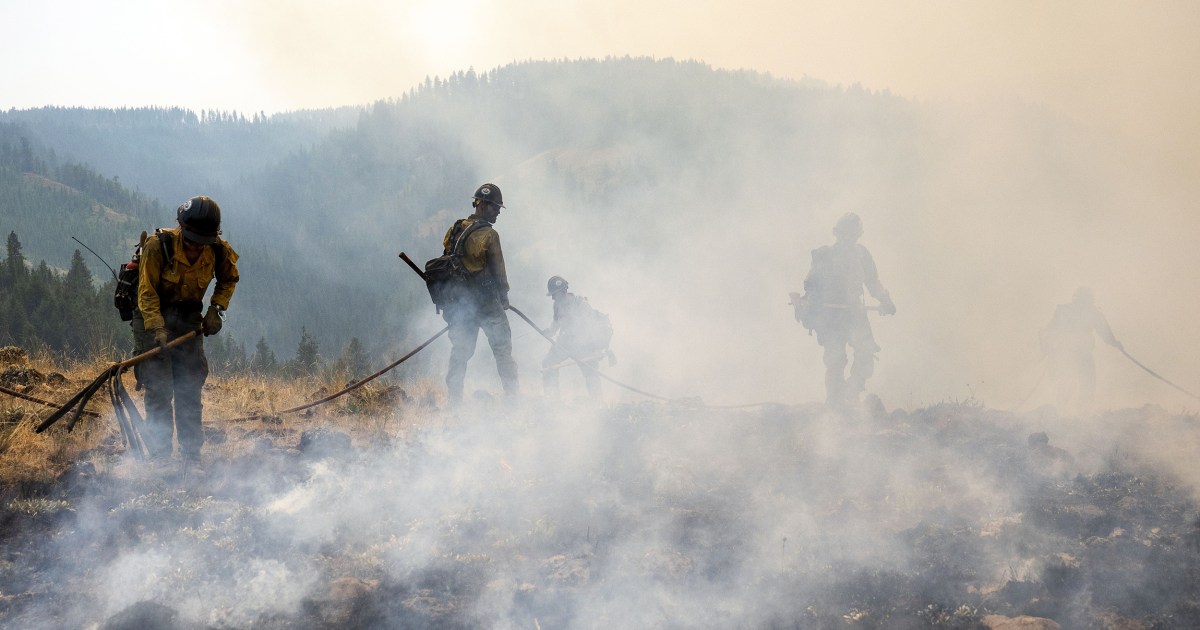
Wildland firefighters heading to some of the country’s largest conflagrations will be faced with dwindling supplies in the coming weeks — including water, food and communications equipment — according to two memos issued this week by the National Interagency Fire Center and obtained by NBC News.
One memo instructs firefighters and incident management teams to bring a personal stash of food, water and other supplies to last them three days.
A second memo warns that “due to the increased demand and numerous long duration fires,” communication equipment, including handheld radios and travel support, is “critically low.” As a result, firefighters should modify their attack plans by staying closer together, establishing a lookout and maintaining situational awareness.
“There has been a significant increase in communications equipment orders from the National Interagency Incident Communication Division (NIICD) to supply the radio equipment needed for communications systems that span extremely large incidents,” the memo reads. “A variety of factors contribute to this increased need, including fire size, spatial separation of incident facilities, topography, transportation corridors, initial attack responsibilities and an increased requirement for reliable coverage.”
Together, the memos paint a grim picture of an already overburdened federal firefighting force facing increasingly dire conditions on the ground.
Last month, fuel shortages for air tankers and other firefighting aircraft threatened to ground fleets amid an increase in demand, The Associated Press reported. Ongoing heat waves and drought throughout the West have also exacerbated conditions, making fires longer, hotter and harder to contain.
While rationing supplies is not necessarily unheard of during busy fire seasons, these directives came much earlier than anticipated.
“I wouldn’t say it’s extraordinary, but I would say it’s unusual for this time of year to see this high demand,” said Carrie Bilboa, a spokesperson for the National Interagency Fire Center. “This year started so soon and these large fires are continuing. They’re extending months long.”
In Northern California, firefighters have spent nearly a month battling the ravenous Dixie Fire, which leveled a historic Gold Rush-era town and destroyed nearly 900 buildings. It has burned more than 500,000 acres and was 30 percent contained as of Wednesday, according to the California Department of Forestry and Fire Protection, or Cal Fire.
At least 105 large fires are now raging across 14 states, scorching some 2.4 million acres. The Richard Spring Fire in Montana is showing “extreme fire behavior” and made a “significant run” of nearly 90,000 acres in the last 24 hours, according to the National Interagency Fire Center, which warns of increased fire threats for Northern California, the Pacific Northwest, portions of the Great Basin and Northern Rockies “due to hot, dry, and windy conditions and the potential for lightning.”
Across the Pacific Northwest, temperatures are forecast to soar 10-20 degrees above average, resulting in highs in the 90s to 100s for coastal as well as inland cities. This is the sixth heat wave for a region that just experienced its hottest June and July combined on record, and the relentless heat is fueling the wildfires.
Source: | This article originally belongs to Nbcnews.com









